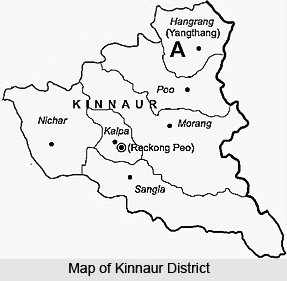 Kinnaur district is situated on the Indo Tibetan border. This beautiful district of Himachal Pradesh is surrounded by Garhwal Himalayan to the south and Tibet to its east. Kinnaur is located around 200 km from Shimla. Kinnaur conjures up a picture of inaccessible valleys, of the Hindustan-Tibet road, of the mighty gorge of Satluj and different customs. Sutlej River rises on the southern slopes of Kailash Mountain in Tibet and flows through the Kinnaur valley. Kinnaur is defined as the land of legends and mythology.
Kinnaur district is situated on the Indo Tibetan border. This beautiful district of Himachal Pradesh is surrounded by Garhwal Himalayan to the south and Tibet to its east. Kinnaur is located around 200 km from Shimla. Kinnaur conjures up a picture of inaccessible valleys, of the Hindustan-Tibet road, of the mighty gorge of Satluj and different customs. Sutlej River rises on the southern slopes of Kailash Mountain in Tibet and flows through the Kinnaur valley. Kinnaur is defined as the land of legends and mythology.
Today, several possibilities for trekkers and mountaineers have opened up at Kinnaur. The earliest explorers to Kinnaur were the Gerard brothers in the year 1818. It was Marco Pallis in the year 1933 the Kinnaur valley to the notice of mountaineers through an article and a book when he climbed Leo Pargial (6791 m), travelled on the Hindustan-Tibet road into the Baspa valley and crossed the Lamkhaga pass to Gangotri. The Hindustan - Tibet road passes through the Kinnaur valley and this route was considered as the main trade road from Tibet, There were many pilgrims who went around the (Kinnaur) Kailash massif, clockwise, from the Tirung valley, over Charang Ghati to Baspa and back and the tradition continues even today. The Army and the I.T.B.P have made many climbs.
Kalpa, situated in the centre of Kinnaur, is the district head-quarters, with one of the finest views one can have while enclosed in a comfortable bungalow. Incidentally, the old name `Chini` was changed to Kalpa, just in case the Chinese had some other ideas! About 760 m below Kalpa there is Rekong Peo, which is developing as the central bazar and administrative town, served by many buses that pass on the Hindustan-Tibet road - from Shimla to Wangtu (where the Inner Line begins), Karchham (bifurcate southeast for Sangla, 17 km), Powari (for Rekong Peo, 6 km and Kalpa, 13 km), Akpa (for Morang and the Tirung valley), Kanam (for the Gyamthang valley), Shi Asu Khad (for the Ropa valley), Puh (old Poo), Leo and Chango (for Leo Pargial in the east). The road continues to Kaurik and Sumdo to enter Spiti and reach Kaja. Over the years, there have been several developments in Kinnaur that have opened up many possibilities for the local people and the valleys are now far more accessible to mountaineers. Like for instance, an afternoon bus from Kalpa will reach Shimla on the same day. These developments have not yet taken a heavy toll of the forest cover, culture and peace.
A lot has been written on the cultural aspect of Kinnaur. A fusion of Hinduism and Buddhism exists almost in totality. Every village has a temple and a gompa and all worship at both. Various primitive traditions, beliefs and superstitions survive. Legends are held in awe. Though a large proportion of the population is educated, and many serve in the Army. Kinnauri architecture is a thing of beauty to behold. Perched on a hillock, the Kamru Fort or some exquisite gompas and temples can take one`s breath away. The area also has plenty of fruit orchards and the valleys are rich and hospitable.
For such a large district like Kinnaur of Himachal Pradesh, where people have traveled for years, it is not possible to record its mountain and mountaineering history exhaustively. The Satluj literally cuts through the Himalayan chain near Shipki La and then runs through the centre of Kinnaur. There are four major valleys to its southeast and east. These are Baspa valley, Tirung valley (Tidong), Gyamthang valley (Nisang) and Leo Pargial (Hangrang valley). To the northwest of the Satluj lies the other half of Kinnaur. The gentler valleys lead to a divide with Pin valley (Spiti). It has numerous passes which afford many a pleasurable trekking route but offer no climbing higher than about 5900 m.
The important passes of this beautiful district are as follows -
* Tari Khango pass: Bhabha valley to Pin-Parbati pass
* Larsa Way pass: Larsa Garang (Taiti Garang) to Pin valley
* Ghunsarang pass: Ropa valley to Pin valley
* Manirang pass: Ropa valley (to the north) to Pin valley
It was over the Tari Khango that the Indo-New Zealand Himalayan Traverse Expedition passed in the year 1981. It is regarded as a good pass for the trekkers. Historically, Dr J. de V. Graaff reached Manirang pass in the year 1952 and climbed Manirang peak (6593 m) to its northeast. Again its second ascent was in the year 1988 by the Indian Para Regiment (Col B. S. Sandhu). The other peaks climbed in the area are Manirang South in 1982. There are numerous peaks around 5500 metres to 6000 metres in the area which have not been touched. It is evident that in Kinnaur many trekking and climbing opportunities await the mountaineer. There are many side valleys, peaks and passes which are inviting, unexplored and certainly unrecorded. Hence, it can be said that with the tremendous development of roads, the valleys of the beautiful Kinnaur district are one night away from Shimla.






